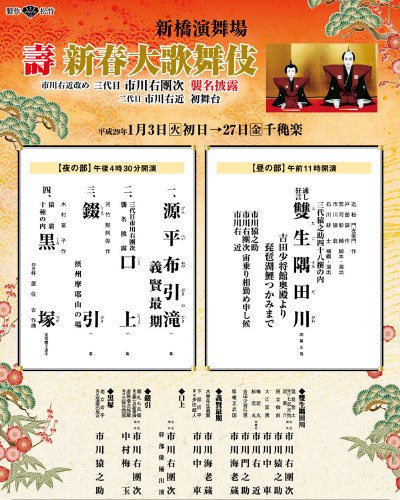| JANUARY 2017 |
| Sh˘chikuza (ďsaka) |  |
| Dates | 2 ~ 26 January 2017 (Kotobuki Hatsuharu ďkabuki) Congratulation Early Spring Grand Kabuki |
| MatinÚe |
Kichirei Kotobuki Soga (Shigitatsusawa Taimen) |
| Evening | |
| Casting |
Living National Treasure Sakata T˘jűr˘, Living National Treasure Kataoka Nizaemon, Living National Treasure Nakamura T˘z˘, Nakamura Shikan, Nakamura Kaishun, Nakamura Ganjir˘, Kataoka Takatar˘, Kataoka Hidetar˘, Band˘ Yajűr˘, Band˘ Takesabur˘, Nakamura Kikaku, Nakamura Matsue, Kataoka Shinnosuke, Nakamura Hashinosuke, Ichikawa Fukutar˘, Nakamura Fukunosuke, Nakamura Utanosuke, Nakamura Kotar˘, Band˘ Shingo, Nakamura Baika, Nakamura Jűjir˘, Arashi Kitsusabur˘, Kataoka Matsunosuke |
| Comments |
The traditional two programs for the New Year Grand Kabuki at the Sh˘chikuza with a troupe led by Living National Treasure Sakata T˘jűr˘. Nakamura Shikan VIII and his three sons, Nakamura Hashinosuke IV, Nakamura Fukunosuke III and Nakamura Utanosuke IV, celebrate their shűmei in ďsaka at the Sh˘chikuza. This is also the 20th anniversary of the Sh˘chikuza which is celebrated.
|
 |
| Kabukiza (T˘ky˘) |  |
| Dates | 2 ~ 26 January 2017 (Kotobuki Hatsuharu ďkabuki) Congratulation Early Spring Grand Kabuki |
| MatinÚe | |
| Evening |
Keisei |
| Casting |
Living National Treasure Nakamura Kichiemon, Living National Treasure Band˘ Tamasabur˘, Matsumoto K˘shir˘, Nakamura Jakuemon, Kataoka Ainosuke, Ichikawa Somegor˘, Ichikawa Sadanji, Nakamura Karoku, Nakamura Matagor˘, Nakamura Kazutar˘, Kamimura Kichiya, Matsumoto Kingo, Ichikawa Komaz˘, Nakamura Takanosuke, Nakamura Kash˘, ďtani Hirotar˘, Nakamura Tanenosuke, Nakamura Kichinoj˘ |
| Comments |
The traditional two programs for the New Year Grand Kabuki at the Kabukiza with a troupe led by the two Living National Treasures Nakamura Kichiemon and Band˘ Tamasabur˘.
|
 |
| National Theatre (T˘ky˘) |
| Dates | 3 ~ 27 January 2017 |
| Program | |
| Casting |
Living National Treasure Onoe Kikugor˘, Nakamura Tokiz˘, Onoe Kikunosuke, Onoe Sh˘roku |
| Comments |
"Shiranui Monogatari" was originally a long novel of the same name, which was written by Ryűkatei Tanekazu (1807~1858) and started to be published in 1849, at the end of the Edo period. It was adapted by Kawatake Shinshichi II and premiered at the Kawarasakiza in the 2nd lunar month of 1853. This play is famous for its visual entertainment. The heroine, Princess Shiranui, has the magical power to turn herself into a giant earth-spider! "Shiranui Monogatari" was extremely popular in koshibai during the Meiji and Taish˘ eras. It was produced 57 times in T˘ky˘ during the Meiji era. 21 times in T˘ky˘ during the Taish˘ era. It was staged only 4 times in ˘shibai the second half of the 20th century: in January 1953 at the Mitsukoshi Gekij˘, in September 1953 at the ďsaka Kabukiza, in August 1954 at the Kabukiza and in March 1977 at the National Theatre. We had to wait almost 40 years for a revival. |
 |
| Shinbashi Enbuj˘ (T˘ky˘) |  |
| Dates | 3 ~ 27 January 2017 (Kotobuki Shinshun ďkabuki) Congratulation New Year Grand Kabuki |
| MatinÚe | |
| Evening | |
| Casting |
Ichikawa Ebiz˘, Nakamura Baigyoku, Ichikawa Ennosuke, Ichikawa Udanji, Ichikawa Chűsha, Ichikawa Monnosuke, Ichikawa Ukon, ďtani Tomoemon, Kataoka Ichiz˘, Ichikawa Unosuke, Ichimura Kakitsu, Ichikawa Emisabur˘, Ichikawa En'ya, Ichikawa Emiya, Ichikawa Juen, Ichikawa Omez˘, Ichikawa Kudanji, Nakamura Yonekichi, ďtani Hiromatsu |
| Comments |
The traditional New Year Kabuki at the Shinbashi Enbuj˘ with the shűmei of Ichikawa Udanji III and the hatsubutai of his son Ichikawa Ukon II.
|
 |
|
|||
| Dates | 2 ~ 26 January 2017 (Shinshun Hanagata Kabuki) New Year Young Actors Kabuki |
||
| MatinÚe |
Otoshidama (Nenshi Goaisatsu) Keisei Hangonk˘ (Domo Mata) |
||
| Evening |
Otoshidama (Nenshi Goaisatsu) |
||
| Casting |
Nakamura Kinnosuke, ďtani Keiz˘, Band˘ Minosuke, Nakamura Kazutar˘, Onoe Matsuya, Nakamura Hayato, Nakamura Umemaru, Nakamura Kamenoj˘ |
||
| Comments |
The yearly show for young promising actors at the Asakusa K˘kaid˘ in Asakusa, a lively and colorful neighboorhood that keeps the scent of old Edo.
|
||
 |
|
|||
| Dates | 9 ~ 24 January 2017 (Zenshinza Hatsuharu Tokubetsu K˘en) Zenshinza Early Spring Special Performances |
||
| Program |
Mitsu Moyau Genji no Hataage (Ushiwakamaru) |
||
| Casting |
Arashi Keishi, Kawarasaki Kunitar˘, Fujikawa Yanosuke, Arashi Yoshisabur˘, Motomura Yűki, Nakajima K˘tar˘, Tadamura Shin'ya, Yagyű Keisuke, Yamazaki Tatsusabur˘, Hayase Einoj˘, Matsunami Kihachir˘, Arashi Ichitar˘ |
||
| Comments |
The traditional Zenshinza New Year performances in Ky˘to. As the Minamiza is closed, it is staged at the Pontoch˘ Kaburenj˘, a venue in the famous hanamachi district of Pontoch˘. The Zenshinza troupe celebrates both the 85th anniversary of its foundation and the 40th anniversary of its early spring special performances in Ky˘to.
|
||
 |
|
|
| Contact | Main | Top | Updates | Actors | Plays | Playwrights | Programs | Links | FAQ | Glossary | Chronology | Illustrations | Prints | Characters | Derivatives | Theaters | Coming soon | News |
